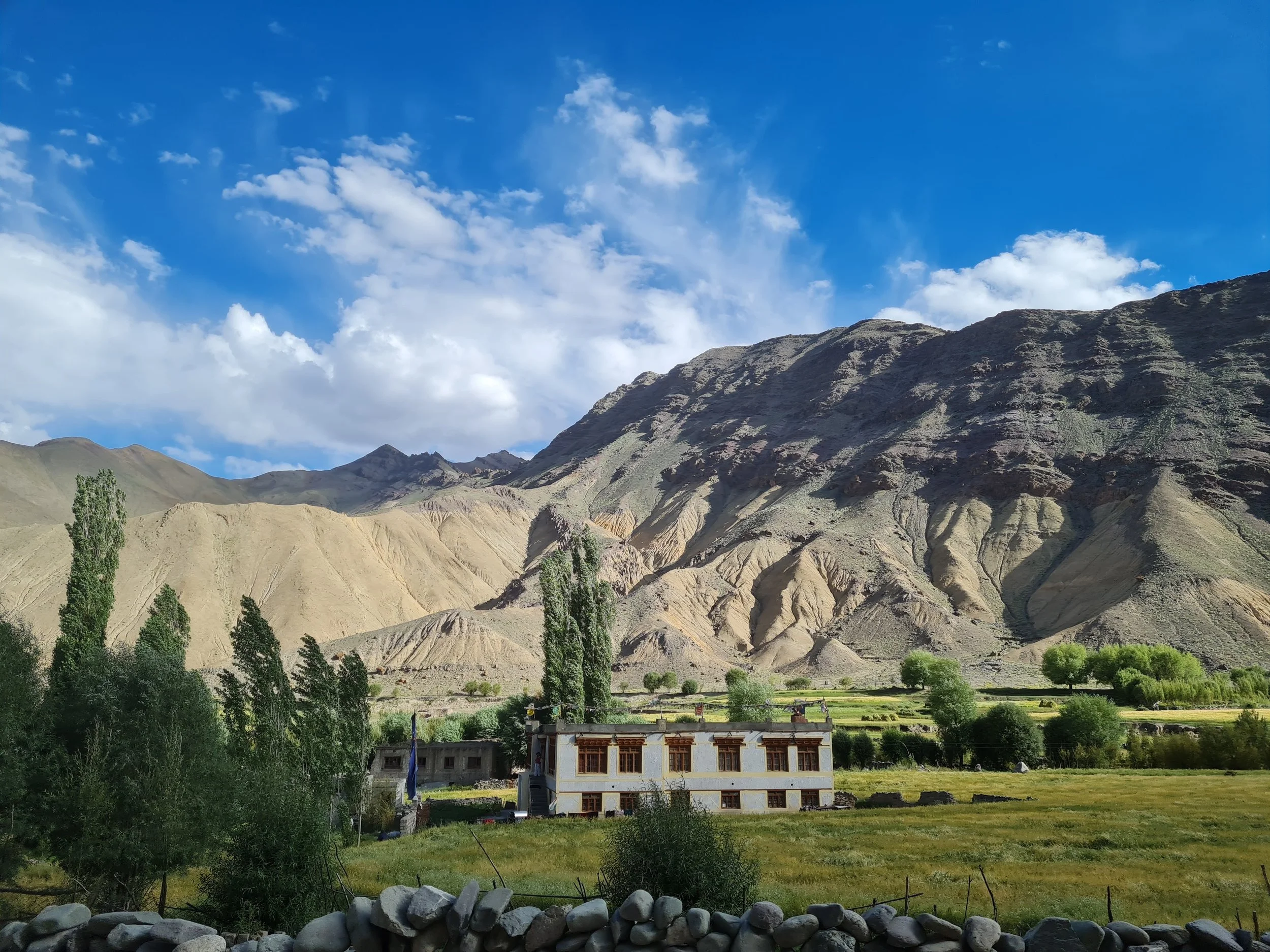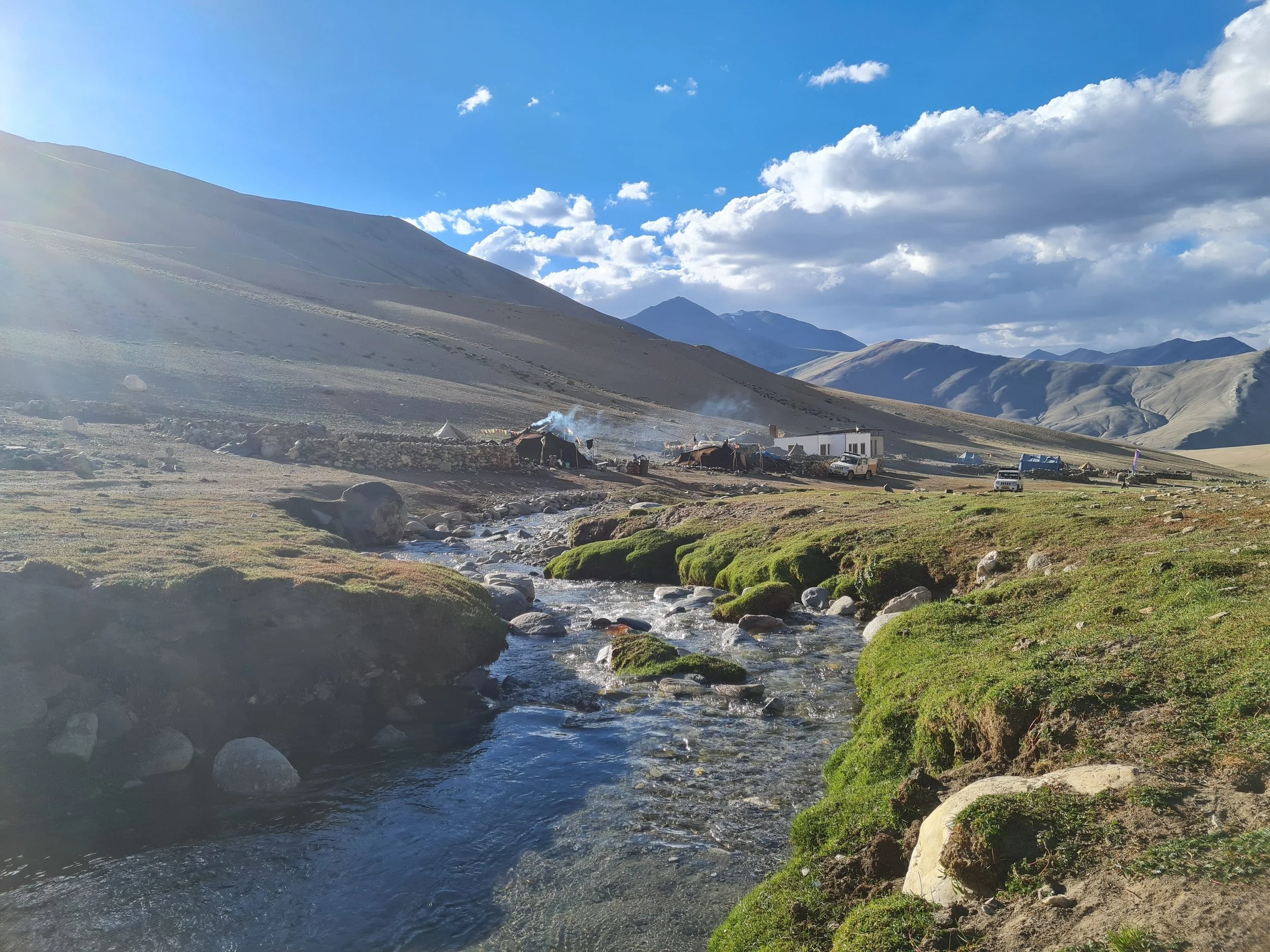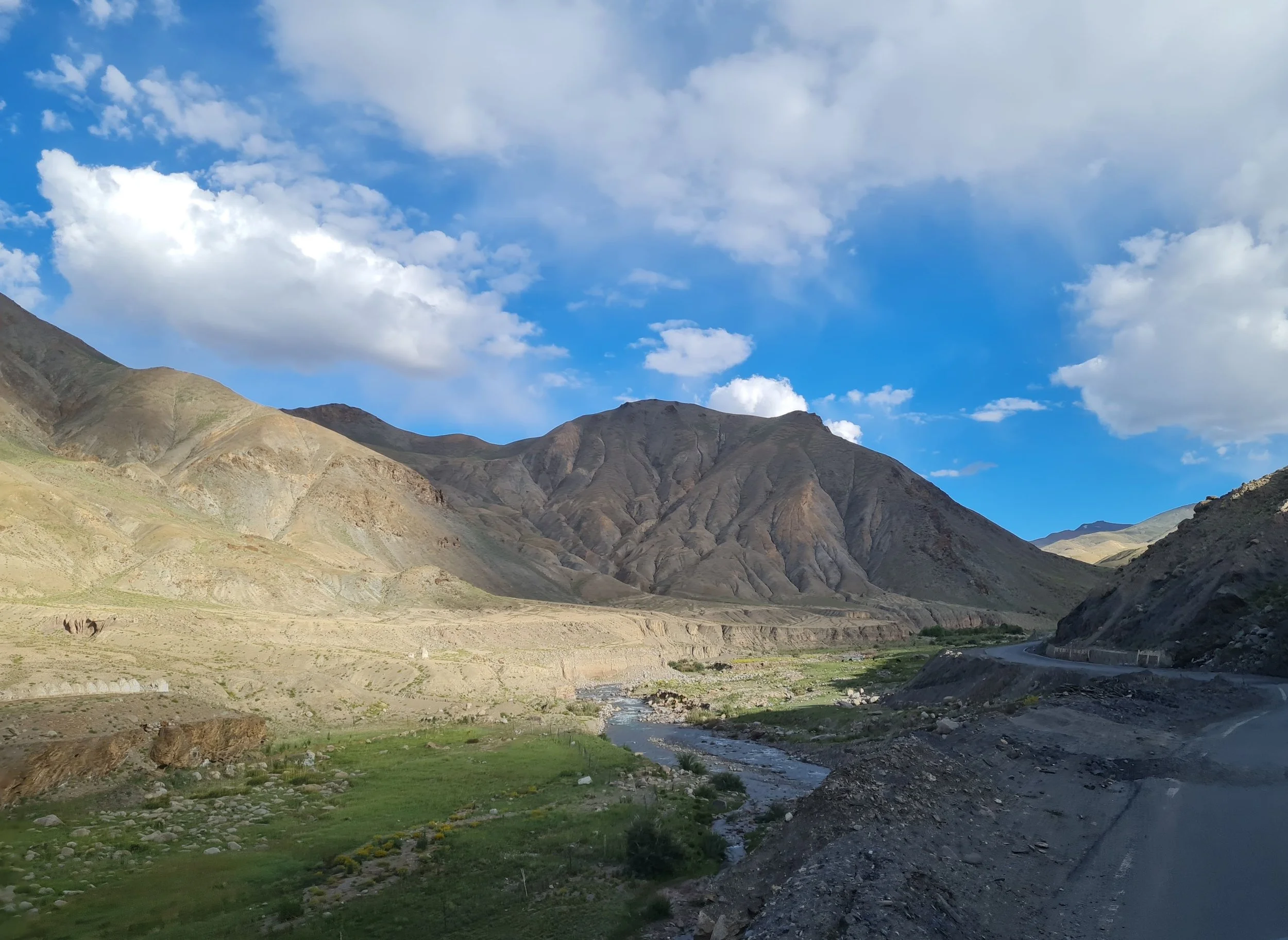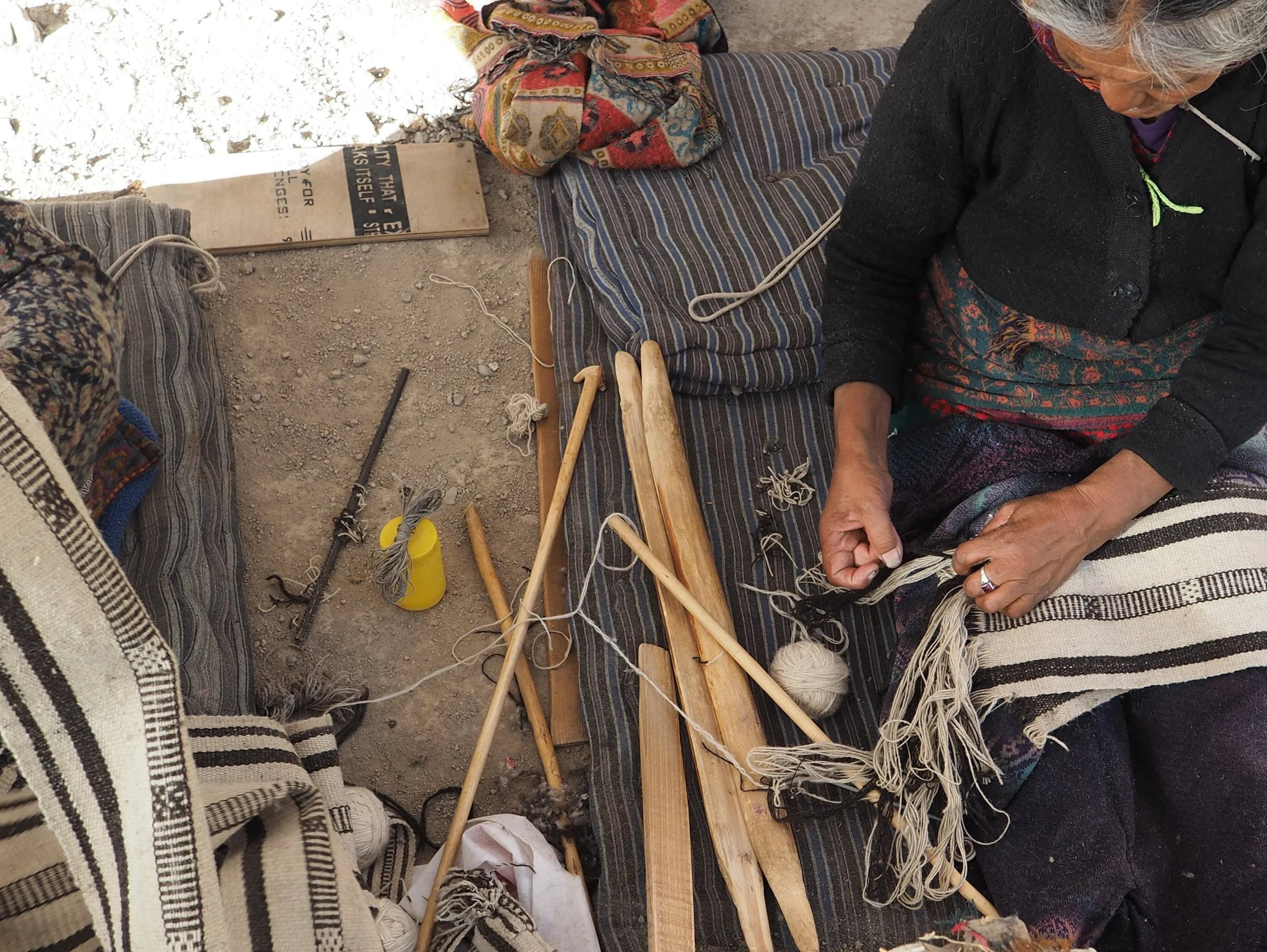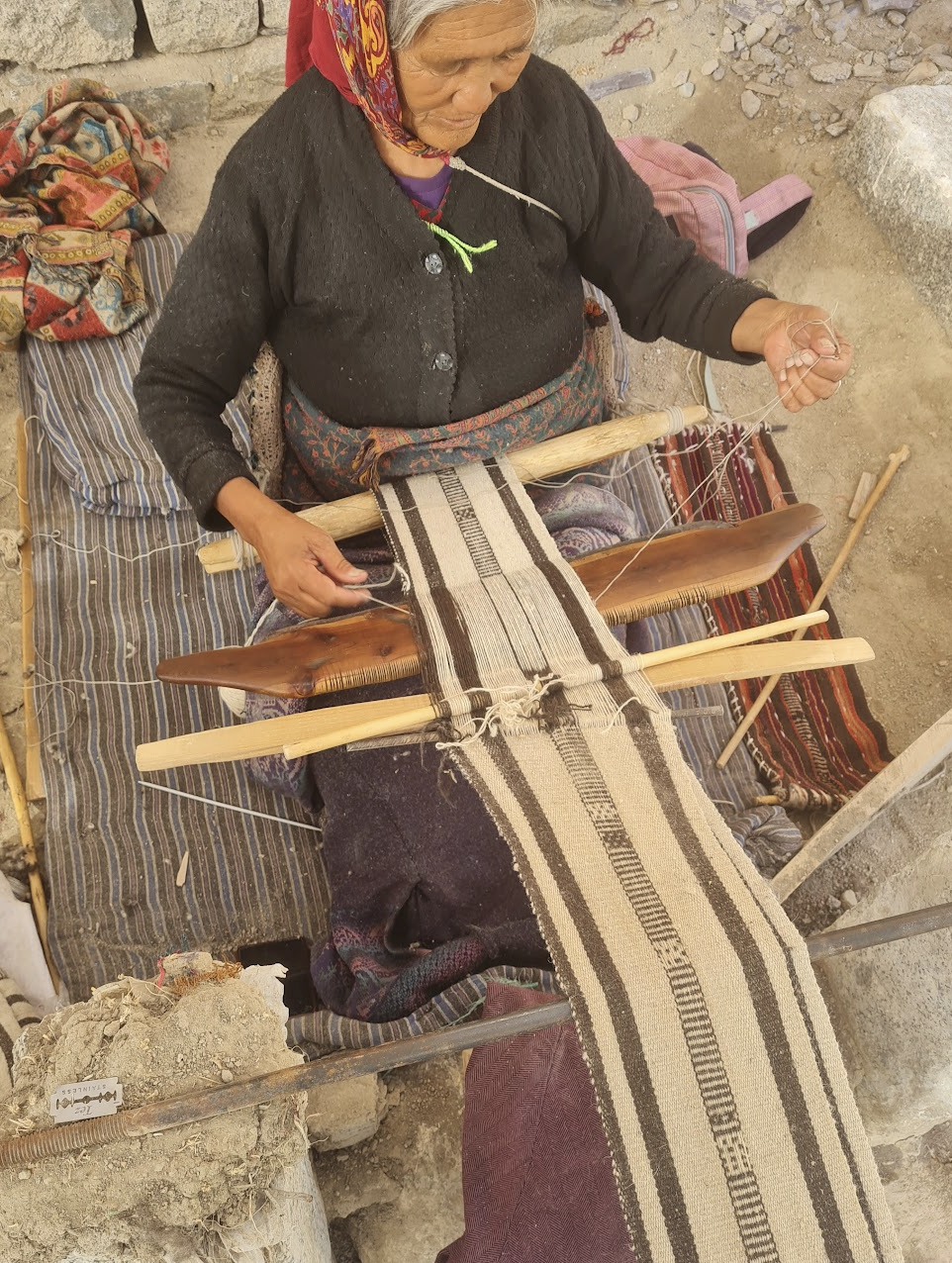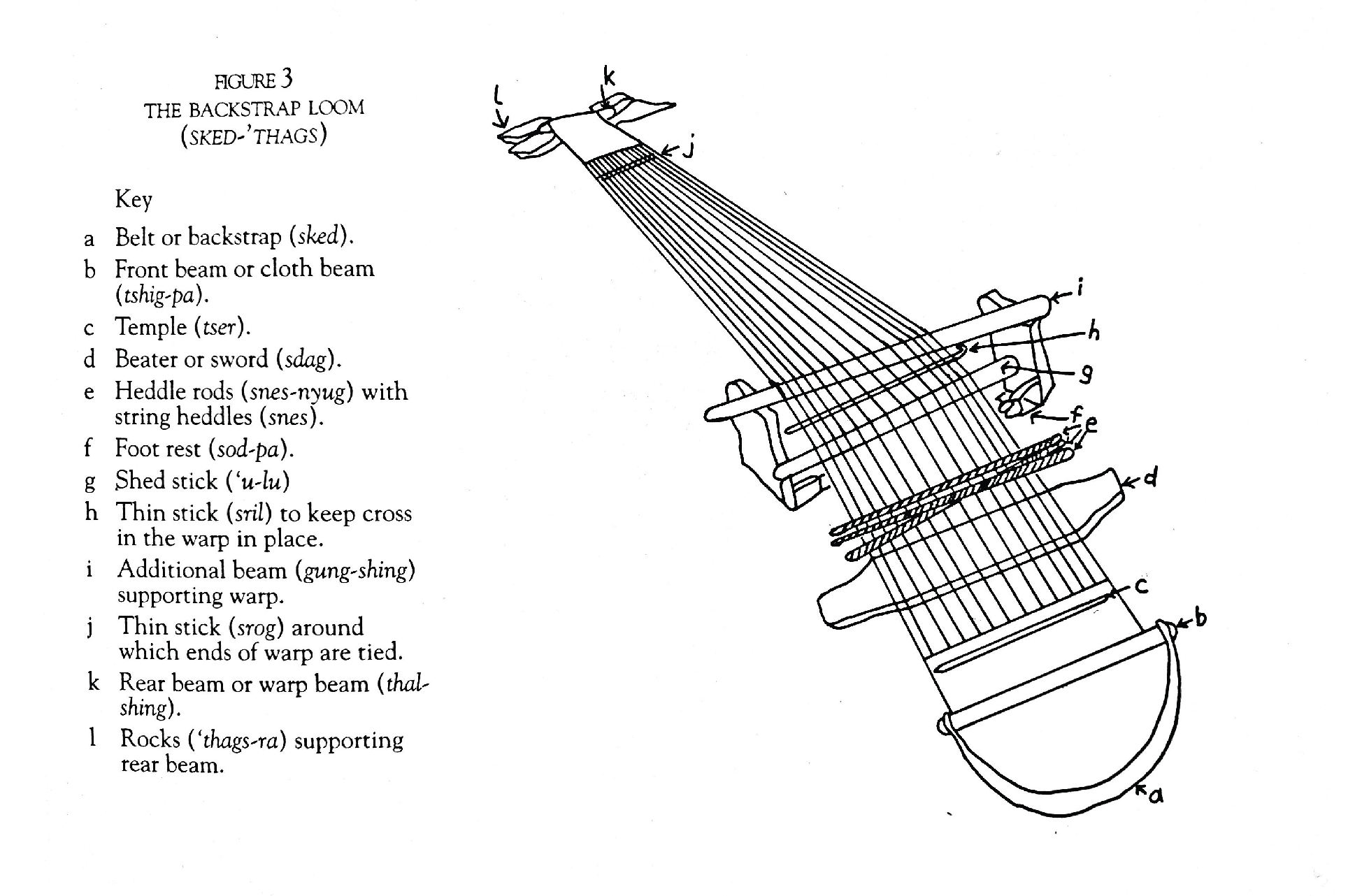LADAKH // August 20, 2023
first impressions
A feeling of dissolution and deeply felt serenity. Sharp mountain peaks covered in snow and bright sunlight welcoming crisp warmth to exposed skin. A soft breeze blowing through the willow trees whose determined roots reach far into the dry earth, gathering moisture from deep below. Butterflies and bees swirling through the dye garden, now saturated with late summer purples and dotted with sunset orange-yellows. The sounds of workers building a mudbrick house across the way drifting over on the wind and from beyond the call for midday prayer.
Ladakh was first introduced to me through the 2010 documentary,Schooling the World, which shines a light on the loss of cultural knowledge through the colonizing influence of the modern, Westernized school system. Already the first four minutes of the film are incredibly eye-opening and show the imperialist incentives of European settlers in their quest to destroy indigenous cultures and their connection to the land. Helena Norberg-Hodge, a linguist, author and activist that lived in Ladakh over a forty year span, speaks in this film and further shares her perspective of the transformation she witnessed in her book titled,Ancient Futures; Learning from Ladakh. She writes,
One of the most striking lessons that changing Ladakh has taught me is that while the tools and machines of the modern world in themselves save time, the new way of life as a whole has the effect of taking time away. As a result of development, Ladakhis in the modern sector have become part of an economic system in which people have to compete at the speed of available technologies.(1)
Ladakh and the local way of life is special for many reasons, but a main one is a closeness to nature and a simple way of living, that in the industrial world has evaporated from our understanding. There are still nomadic communities that exist, and through an apprenticeship with the social enterprise, we are KAL, I have the privilege of connecting with them.
We are KAL works closely with the nomadic community, the Changpa, who inhabit the Changthang plateau, on the border between India and Tibet in high Himalayas at about 5,000m. The community used to be comprised of nearly 100 families, but has now shrunk down to only 14, living in rebo tents traditionally made of yak hair. Each family owns several hundred animals; sheep, goats and yak, that are taken up into the mountains each day by a shepherd.
A few days after arriving in Ladakh, and getting acclimated to the altitude, we drove up to spend a few days in Karnak. We packed the truck with tents, warm clothing, fresh vegetables and baked goods, and drove up into the mountains. I watched the landscape transform from the bed of the truck, as we wound through red rock mountains and along an ice blue river. The colours were breathtaking ~ bright purple wildflowers dotted red rock mountains and along the roadside wound an ice blue river. As we drove higher and higher, the greenery disapeared and the temperature dropped. The jagged rock softened and the mountains opened into barren hillsides, as we reached the plateau.
In the fading light, we set up the tents and put on our additional layers, and then joined Angtak’s family in the rebo for a warm meal cooked over the small iron stove. Our cups were soon filled with hot butter tea as we gathered around in a circle. From far corners of the world and now together here. Outside, the stars shone brighter than I’ve ever seen.
1. Ancient Futures by Helena Norberg-Hodge, page 106. Also a documentary.
LADAKH // August 28, 2023
way of life
Early morning on the Changthang plateau. Despite being the warmest summer month, the air is crisp and smoke rises from the rebos dotting the stream in the valley below. I hear voices drift down from above and look to the stone structure next to my tent, to see two women on the roof, chatting and making cheese. By squeezing the clotted milk through their fingers they are creating long clusters which are then dried in the heat of the sun. It is one of the numerous ways of transforming the yak milk, which serves as a primary form of nourishment in this otherwise unfertile landscape. Without means of electricity or the ability to keep things cool, drying cheese and meat is an essential strategy.
Each day, before the first light peers over the mountain, the community is awake. The shepherds are the first to rise, taking turns gathering their flocks and heading up into the mountains. Each family has approximately 400-700 animals, who are tended to by a single herder. Watching them gracefully control such a multitude of animals is astounding. With a couple perfectly aimed rocks, they are able to direct the herd’s movements, moving them in synchronicity across the rocky landscape.
The yak, sheep and goats provide the foundation to the Changpa’s way of life. The goats are their primary source of income, being a rare breed produces a fine grade of cashmere called pashmina. The harmony with which the lives of humans and animals are intertwined and the ingenuity of their interrelation, is impressive. Their way of life is still very connected with the traditional lifestyle, each year brings more influence from the outside world. Now, several members of the community own a vehicle, and children are sent away to school - most of them not choosing to return.
One evening we were invited to dinner by Topdan and his daughter Lamo. Lamo has three small children who are going to school and living with her husband in Leh, the capital city of Ladakh. Lamo’s choice to remain in Karnak was closely linked with the familial and communal responsibility of keeping their way of life alive. Her siblings had all moved away and she was only one that was left to care for her father and maintain their home. Lamo’s children will grow up with modern schooling and access to basic comforts but they will not know to the warm embrace of their mother or learn the vastness and language of the land.
It is undeniable that this life is hard, yet it also holds invaluable aspects and extremely necessary teachings. The invitation is to honor both, slowly and mindfully adopting transitions that improve the lives of children while continuing the respect and recognition of our older generations...
~
photo to the top left of Tsering Yudon getting wool from her shed. August 17, 2023.
LADAKH // September 10, 2023
weaving into being
“Kinship and descent are for a community the ‘flow of life’; cloth can be the essential mediator. In Rupshu, the woven cloth is seen as an expression of a family network - a medium that links men to women, and mothers to their children. These concepts are echoed through Abi Yangzom’s words... ‘Warp and weft are always there in relationships... After all, we are all warp and weft.” (1)
Sitting within the embrace of the backstrap loom—the most common form of weaving for the women of Ladakh— one does not take long to relate to nurturing a life. The continuity, the connection, the tension held through the body ~ from toes to fingers, and transferred into the fibers. It is easy to get lost in the rhythmic back and forth of the weft thread, as it moves through alternating tunnels of warp, lifted with a light wooden branch. With each passage, the threads feel more familiar and the mind is freed to wander. Being quite literally bound to ones practice leaves little room for restlessness and even less for distraction, especially when a single missed thread will affect the integrity of the whole piece.
Backstrap loom is practiced in Ladakh and mainland India, as well other parts of Asia, Africa and the more southern Americas. It is quickly being replaced with larger and more industrial looms, yet holds a singularity through its special, organic nature.
Beyond the physical creation of cloth, weaving is a practice that connects us to our ancestors and to ancient cultures all across the world. It is more than a machine that has now been replaced with something more efficient, but it is a method of meditation and meaning-making that is invaluable. It enables a deeper understanding of the material and an active involvement in its transformation that is empowering as well as political.
1. Living Fabric, Weaving among the Nomads of Ladakh Himalaya by Monisha Ahmed
LADAKH // October 10, 2023
conversations with KAL
During my last week working with we are KAL, I sat down with Catherine, the founder/creative director and the women from the Karnak nomadic community
What is the main message you wish to communicate through we are KAL?
Catherine: The main message we are all trying to communicate is the value of crafts from back in the day that are losing importance and demand. The world we live in is geared towards more quickly produced items; quick in general - quick satisfaction, quick results… We want to create appreciation for these traditional crafts and that way of life and of making. To really go slower, it takes time. Starting from the practice itself, but then even how climate affects us in the way we work. In Assam, for example, during the monsoon we are not able to do the same speed of work as we usually do and things don’t dry as it is always humid. Here in Ladakh, it is the same in the winter, you just can’t wash huge amounts of wool. So we also hope to communicate that we all have to go at our own pace.
How has your vision changed in the nine years since founding the company?
C: Instead of adding new raw materials or new techniques, we rather continue to strengthen the work within our own community. For me, the place is the most important. The people, especially, and of course, the local raw materials. In that way, this real strong focus on the small group that makes up our team, that has changed. Even though I am curious and would love to work with other raw materials, I just feel like these are the limits of our work. Rather have the focus on these two places, two raw materials [wool and silk], rather than being all over the place.
How has the collaboration with the women, in Assam but more particularly in Ladakh, changed your way of work creating and communicating?
C: We have both learned much from each other, especially in regards to the way things need to be done. I have accepted it will not always be the same, it is always a new creation for the women. And it doesn’t matter as long as the size is accurate and the overall look is more or less like the picture on the website. The women need some freedom in terms of the design and with handspun yarn and natural dyes, the product will anyway always look a bit different. This is simply our way of working and the products thus convey the character of the work.
How has your involvement with the community of Karnak shifted your way of viewing the world?
C: I have become a lot more open in terms of lifestyle and a lot less fixed on what I need. Of course, I do have a few things that I really need and are important to me, but especially if it is temporary, I have become a lot less reliant on and demanding of things. My tolerance to difficulties has also gone up a lot. To see the importance of the community; what they can do and how powerful that is. This we don’t really experience so much anymore in the west. At least I’ve not experienced it in such a way. Family structures can be strong but overall community structures where there’s more than circa 20 families involved, this we don’t really have anymore. So l’ve learned quite a lot from that. Simply to be more supportive to other people to be part of this entire system of supporting each other - this is something very valuable I’ve taken from [this way of life].
What is something in the work or in the process over the past years that you are most proud of and what is something you are looking forward to in the future?
C: I would say it is to simply to have survived over so many years, as the majority of start-ups don’t manage to become established companies. The other is that we have established a good team and atmosphere and people are happy to be working with us. We are remaining true to the principles that I’ve had since the beginning, and are still working with only hand-spun and naturally dyed yarn. This is not easy and there aren’t many brands who do this, but we have remained committed.
In times of difficulty or doubt, what renews your trust and your strength?
C: There’s always periods of doubt and sometimes you feel as if it is not working at all as expected. In these times I ask, what could this be good for? Because any issue that you encounter turns out to be an indicator of a different direction that you have to go or that will in the end benefit your work. It is an obstacle but you overcome it. and then it will benefit your work and the way that you also function because after all it is you who has to manage how everything works day to day, so If there’s some doubt or some issues I try to already of positive impact could this have in the future and what do I learn from it? This is something that helps me.
Who do you look up to or draw inspiration from?
C: For me, it is people that manage to do things despite great difficulty. For many, encountering difficulty makes them abandon their idea and so I think this type of strength is really admirable. I also appreciate those who are role models in managing their life as well, apart from running a company. How you can genuinely keep everything in balance and not just say it or strive to be so. And of course, I am always inspired by my mother as well.
What final words would you like to leave us with?
C: I think everybody has something they really wish to do or that is their dream or that they’ve been working on so hard. And, while you always have to question what you’re doing, I think it is also important not to lose faith in what you are doing because other people tell you it is not good. If you have a strong idea then just continue working on it - being flexible, but not losing the magic that made you start it in the first place. ༄
The women of Karnak shared their thoughts on shifting from their nomadic way of living to a settled life in the city ...*
What are the most significant ways your life has changed since relocating to Karnak-ling?
Ane Padma Angmo: The main way is that nearly all the difficulties are gone. In Karnak there were many hardships, such high snow and we had to climb through it up the mountains. Now that I am here there’s no longer the need to work so much, there are fewer challenges and much more ease. I only miss the summertime. In the summertime I am so happy there but winter is so difficult. There are no problems in the summer there, these times I miss.
Ane Tsering Angmo: Here, life is easier. There is no need to go through these tough, difficult things. Now I don’t need to do so many kinds of work - to tend to all the animals, to climb the mountain with all the snow, and also, to do all the food preparation by myself.
How is the work with ‘we are KAL’ different to the way you were working before (when making was directly related to the needs of the family)?
Angtak: They are saying this work is so light compared to the work they did before. They are happy and always talking and have a good relationship with [Catherine and Angtak]. They know this work since the beginning so it feels very natural and comes easily to them. They are very happy, they say. It is always entertaining. Sometimes they fall asleep too, which is not intentional but sometimes the work is also very calming (they say, laughing).
What do you wish people knew and understood better about your culture and way of life?
Angtak: The women said they are happy about the visitors that come to see the work, and feel the admiration and interest in their process. Rather than wanting to share more about themselves, they wish they were better able to communicate and to welcome them and ask questions of their own. They are very curious about their way of life and wish they could ask them more questions. They would like to ask what visitors think and how they feel about their work.
What are some beliefs and practices you wish your children would carry onward?
And Tsering Angmo: What my husband and I did, while practicing this nomadic life, we wanted to pass to our children but they were not interested to learn. So there was no choice. The tent making and the weaving, we wanted to share this with them but they did not care. Now my son is a truck driver and he has no time.
Ane Padma Angmo: I also dreamed my son would follow these nomadic practices but he doesn’t want to. He just does whatever he wants. I wish he would carry on these parts of our life but he makes his own choices and there’s not really any option.
Ane Yang Dul: For my son it is the same. He is a taxi driver and it is easy money and an easier life. The children are choosing the easier path and we are not able to influence the decisions they make any longer.
If you could weave a message into the pieces you are making, what would it be?
Tashi Chodon: I would like to convey the process of the work that is going on here and the story of Karnak. The population is slowly shrinking and all the work practices are also slowly becoming lost as less people are practicing them. We wish many people from all over the world would also help carry on the practices, little by little so that they will not disappear and the knowledge will continue. ༄
* big thank you to Angtak for translating!



